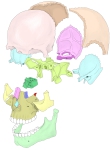鋤 骨 (じょこつ、英:vomer)
■ 写真やイラストを掲載しているサイト ■
■ Wikipedia ■
The vomer (/ˈvoʊmər/[1][2]) is one of the unpaired facial bones of the skull. It is located in the midsagittal line, and articulates with the sphenoid, the ethmoid, the left and right palatine bones, and the left and right maxillary bones. The vomer forms the inferior part of the nasal septum in humans, with the superior part formed by the perpendicular plate of the ethmoid bone. The name is derived from the Latin word for a ploughshare and the shape of the bone.
【In humans】
The vomer is situated in the median plane, but its anterior portion is frequently bent to one side.
It is thin, somewhat quadrilateral in shape, and forms the hinder and lower part of the nasal septum; it has two surfaces and four borders.
The surfaces are marked by small furrows for blood vessels, and on each is the nasopalatine groove, which runs obliquely downward and forward, and lodges the nasopalatine nerve and vessels.
【 語 句 】
・facial bones:顔面頭蓋 ・midsagittal line:正中矢状線 ・articulate with~:~と関節する ・sphenoid:蝶形骨 ・ethmoid:篩骨 ・palatine bone:口蓋骨 ・maxillary bone:上顎骨 ・nasal septum:鼻中隔 ・perpendicular plate:垂直板 ・ploughshare:=plowshare 鋤 ・quadrilateral:四辺形の ・hinder part:後部 ・furrow:溝 ・nasopalatine groove:鼻口蓋溝
【Borders】
The superior border, the thickest, presents a deep furrow, bounded on either side by a horizontal projecting expansion of bone – called the wing of vomer; the furrow receives the rostrum of the sphenoid, while the margins of the alae articulate with the vaginal processes of the medial pterygoid plates of the sphenoid behind, and with the sphenoidal processes of the palatine bones in front.
The inferior border articulates with the crest formed by the maxillæ and palatine bones.
The anterior border is the longest and slopes downward and forward. Its upper half is fused with the perpendicular plate of the ethmoid; its lower half is grooved for the inferior margin of the septal cartilage of the nose.
The posterior border is free of bony articulation, having no muscle attachments. It is concave, separates the choanae, and is thick and bifid above, thin below.
【Articulations】
The human vomer articulates with six bones:
- two of the cranium, the sphenoid and ethmoid.
- four of the face, two maxillae; and two palatine bones.
It also articulates with the septal cartilage of the nose.
Vomeronasal organ
The vomeronasal organ, also called Jacobson's organ, is a chemoreceptor organ named for its closeness to the vomer and nasal bones, and is particularly developed in animals such as cats (who adopt a characteristic pose called the Flehmen reaction or flehming when making use of it), and is thought to have to do with the perception of certain pheromones.
【 語 句 】
・rostrum of sphenoid:蝶形骨吻 ・wing of vomer:鋤骨翼 ・vaginal processes:鞘状突起 ・medial pterygoid plate:翼状突起の内側板 ・sphenoidal process:蝶形骨突起 ・septal cartilage of the nose:鼻中隔軟骨 ・choanae:後鼻孔 ・bifid:二分の ・Vomeronasal organ:鋤鼻器官、鋤鼻器 ・chemoreceptor:化学受容器 ・Flehmen reaction:フレーメン反応 ・perception:認識 ・pheromone:フェロモン













